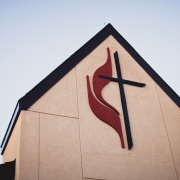Photo Courtsey of Pixabay.
Controversy is ramping up over abortion, as several states have passed more restrictive laws and some are contemplating the possibility that the Supreme Court might reverse the Roe v. Wade decision legalizing abortion. The proposed new Global Methodist Church is unequivocal in support of a pro-life position. How are we to think about abortion in today’s social context?
The church would do well to follow the lead of Mother Teresa, the Albanian-born nun, who is best known for tending the needs of people in the slums of Calcutta, India, and received the 1979 Nobel Peace Prize for her work with the poor worldwide. “Abortion has become the greatest destroyer of peace, because it destroys two lives, the life of the child and the conscience of the mother,” she said, as reported in the Los Angeles Times. “Let us thank our parents for wanting us, for loving us, for giving us the joy of living. … You are priceless to God himself.
This is obviously a controversial and emotionally fraught issue. We need to pay attention to the experiences and feelings of women facing unwanted pregnancies and be prepared to support them from a pro-life perspective. There is also a need to think clearly, biblically, and theologically about the moral aspects of abortion, as well as being informed by the best science. My main concern is how Christians ought to put our beliefs into practice in our personal lives, more than how our beliefs should influence governmental laws regulating abortion.
The question hinges on how we understand the life that exists within a woman’s womb. Is it a human person? Is it a blob of cells? What exactly are we dealing with here?
There seems to be broad consensus that what exists within the womb is alive. After all, it is growing and developing and even has a detectable heartbeat by the sixth week of pregnancy.
Part of the Woman’s Body?
Some would say that a fetus is simply part of a woman’s body. Having an abortion for some is the moral equivalent of removing a tumor or having plastic surgery.
Against this view is the fact that a fetus has different DNA than its mother. If the fetus were simply part of the woman’s body, it would have the same identical DNA as the mother. But of course the fetus has both the mother’s and father’s DNA, combined in a new and unique way, so it has a distinct life from that of the mother.
While it is completely dependent upon the mother for sustenance, the fetus reacts independently to external stimuli. The fetus has periods of wakefulness and activity, independently of what the mother might be doing at the time. The fetus can respond to the sounds of music or the parents’ voices.
In Luke 1, we read how the baby John the Baptist leaped in his mother Elizabeth’s womb when he heard Mary’s voice. As Elizabeth reports, “But why am I so favored, that the mother of my Lord should come to me? As soon as the sound of your greeting reached my ears, the baby in my womb leaped for joy” (Luke 1:39-45).
Ultrasound technology shows us that a fetus has a life and existence of its own. When it comes to the baby in the womb, the mother is dealing with a separate new life, which takes the question into a different moral category.
As reported by Emma Green in
The Atlantic, activist Ashley McGuire recounts her own experience of pregnancy. “When you’re seeing a baby sucking its thumb at 18 weeks, smiling, clapping,” it becomes “harder to square the idea that that 20-week-old, that unborn baby or fetus, is discardable.”
The question still remains whether the life within the mother is human and whether it is a person with all the rights and protections of a human being.
Here again, science comes to our aid. When the fertilized egg implants in the uterine wall, it has all the necessary genetic code to describe its unique existence. From that point on, it is a matter of development. That development takes place rapidly and gradually over the course of the nine-month pregnancy. Even after birth, that development continues until a person reaches physical adulthood in their late teens. At what point during that development does a life go from being non-human to human? Or from being a non-person to being a person?
The Supreme Court in a later decision chose viability as the point at which the unborn child gains some potential protections of the law. That is the point at which the baby could survive outside the mother’s womb. That point is very difficult to establish, however, and medical advancements have been pushing the point of viability earlier in pregnancy. Crucially, what is different the day before a baby is viable from the day after is simply growth and development. No new physical structure is formed that yields viability. The baby has simply grown to the point where it could sustain its own life outside the mother’s womb.
The recent Texas law established a fetal heartbeat as the point at which the baby gains the right of protection. This is a more objective standard, since it can be determined without question from outside the womb. It marks a definite change in the status of the physical development of the baby. But again, there is nothing intrinsically different in an infant before it has a beating heart from after. It is still the same life in development.
Some moralists centuries ago placed birth as the moment when the baby becomes a human person, since it can now breathe the air. They drew upon the image of Genesis 2, where God breathes the breath/spirit of life into the dust, and the man became a living being. I have held and baptized a baby who died in her mother’s womb at nine months gestation. That baby was perfect in every way, except that it was not alive. It was just as much a human person as it would have been, had it been born alive two weeks later.
In some cultures, due to high infant mortality, parents would not name their babies until they were several years old and they had a decent chance of survival. Were those babies less human before they were named?
All these demarcation points are somewhat arbitrary. They are different points along a spectrum of development. The real change that takes place is when a sperm and egg unite to form a new life and it implants in the uterine wall for its life to be sustained. Going from independent cells to a new life is the most defensible demarcation point at which that new life ought to be protected.
“The more I advanced in my field of neonatology, the more it just became the logical choice to recognize the developing fetus for what it is: a fetus, instead of some sort of sub-human form,” said Colleen Malloy, a neonatologist and faculty member at Northwestern University. “It just became so obvious that these were just developing humans.” (Reported in The Atlantic.)
The vast majority of abortions are performed as a “backstop” for contraceptive failure – either a failure to properly use contraception or because the contraception failed to prevent pregnancy. It is important to note that no contraceptive method is 100 percent effective. Sometimes, abortion is considered a form of contraception, but that is really a misnomer. Abortion does not prevent conception, it ends the life that is conceived.
This is where our overly sexualized culture does women a disservice. Women are often expected to engage in sexual relations without any form of commitment by the man, yet women are the ones who bear the consequences in terms of pregnancy. This is fundamentally unjust. But the answer is not to do away with the consequences by ending the pregnancy. Rather, the answer is to return to God’s plan for how we experience our sexual relationships.
God designed sexual relationships to be experienced within the context of marriage, which represents a commitment by the man to care and provide for his wife and any offspring that might be conceived. Without that commitment, women and children are left unprotected and not provided for. An irresponsible man simply expects the woman to have an abortion to eliminate the consequences of his irresponsibility.
Biblical theology teaches that men and women should reserve sex until marriage. This protects the woman from being taken advantage of, and it prevents the vast majority of potential abortions by reserving pregnancy and childbirth to the safety of marriage, where both the woman and her child are provided for. The
CDC reports that 85 percent of abortions are obtained by unmarried women.
This approach to sexuality is counter-cultural. Jesus and the apostles consistently invite us to live by a different set of values and assumptions than our culture does. Such an approach also avoids the emotional pain, emptiness, and even the physical consequences of promiscuity. It is the healthiest way to live.
When discussing abortion, the exceptional cases of rape and incest often assume disproportional attention. They account for less than 2 percent of abortions, according to the
Guttmacher Institute and statistics compiled by the
State of Florida. Pragmatically in terms of secular law, if granting an exception allowing 2 percent of abortions would end 90 percent of abortions, that is a trade-off that could make sense. There is certainly no reason to provoke controversy over the “hard cases,” when the vast majority of abortions do not fit those categories.
“I was adopted nearly from birth,” reports
Rebecca Wasser Kiessling, an attorney, wife, and mother of five. “At 18, I learned that I was conceived out of a brutal rape at knife-point by a seiral rapist. Like most people, I’d never considered that abortion applied to my life, but once I received this information, all of a sudden I realized that, not only does it apply to my life, but it has to do with my very existence.”
It is natural to want to end a pregnancy caused by a traumatic event like rape or incest. But how do we respond to precious souls like Rebecca?
Christians believe that God can work all things together for good and that God can take something meant for evil and use it for good. We must consider why the life of the child should be taken because of the crime perpetrated by the rapist. God can bring healing to the mother through the life of the child. And there are thousands of childless couples looking to adopt babies, for whom such a child could be a real blessing from the Lord.
“Those of us who were conceived in rape are not the ‘hard cases,'” Kiessling has testified. “It is those with the hardened hearts who would condemn an innocent child to death.”
Biblically, life is a gift of God. God creates life and expects us to be good stewards of the life we are given. While the mother and father play a crucial role in bringing new life into the world, ultimately, God is the one who forms life in the womb (Psalm 139:13-16). Children are a gift from God (Psalm 127:3). His purpose for our life dates back before our birth (Jeremiah 1:5). God loves and values unborn children.
The issues around abortion are painful ones to wrestle with, and there are no easy answers. We can prayerfully consider how God would want to use the challenging circumstances in which we find ourselves for our good, the good of others, and his glory. We do not want to close the door on the possibility of miraculously answered prayer.
At the same time, women with undesired pregnancies provide an opportunity for the body of Christ to come around them with love and support that would make that pregnancy manageable. We ought to be the hands and feet of Jesus in serving women and their unborn children with love and acceptance. Often, that support needs to continue past the birth and through the baby’s childhood, particularly for single mothers and women in poverty. The church’s pro-life ethic is not just during pregnancy, but extends through all of life.
Biblically, life is a gift of God. God creates life and expects us to be good stewards of the life we are given. While the mother and father play a crucial role in bringing new life into the world, ultimately, God is the one who forms life in the womb (Psalm 139:13-16). Children are a gift from God (Psalm 127:3). His purpose for our life dates back before our birth (Jeremiah 1:5). God loves and values unborn children.
The issues around abortion are painful ones to wrestle with, and there are no easy answers. We can prayerfully consider how God would want to use the challenging circumstances in which we find ourselves for our good, the good of others, and his glory. We do not want to close the door on the possibility of miraculously answered prayer.
At the same time, women with undesired pregnancies provide an opportunity for the body of Christ to come around them with love and support that would make that pregnancy manageable. We ought to be the hands and feet of Jesus in serving women and their unborn children with love and acceptance. Often, that support needs to continue past the birth and through the baby’s childhood, particularly for single mothers and women in poverty. The church’s pro-life ethic is not just during pregnancy, but extends through all of life.
The church can also offer the forgiveness and healing of Christ for women who regret their decision to abort a child. This is not an unforgiveable sin, and women ought not to be condemned to live with guilt and pain their whole lives. Jesus came to set us free from guilt and shame around all the brokenness we experience, including misjudgments and wrong choices that are costly.
In this cultural moment, Christians have the chance to speak up for the voiceless and powerless – both the unborn children whose lives are at stake and the women who feel compelled toward abortion. We have the chance to live out the ethic of life for both mothers and children. We can live by a different set of values and assumptions than our culture regarding sex and commitment. And we can offer the forgiveness and healing of Christ to a broken world.
Thomas Lambrecht is a United Methodist clergyperson and the vice president of Good News.




 Thomas Lambrecht is a United Methodist clergyperson and the vice president of Good News.
Thomas Lambrecht is a United Methodist clergyperson and the vice president of Good News.

